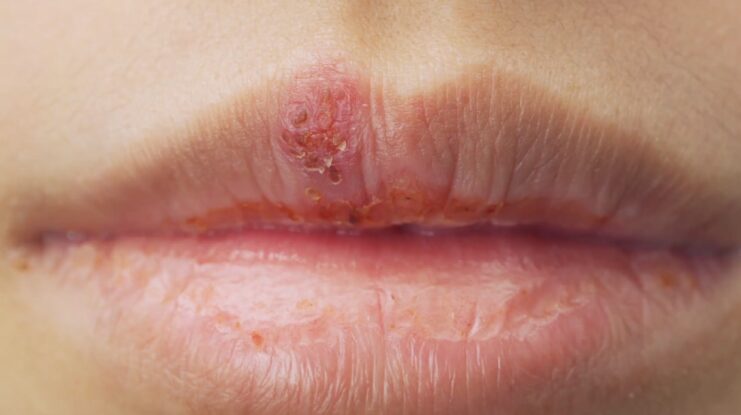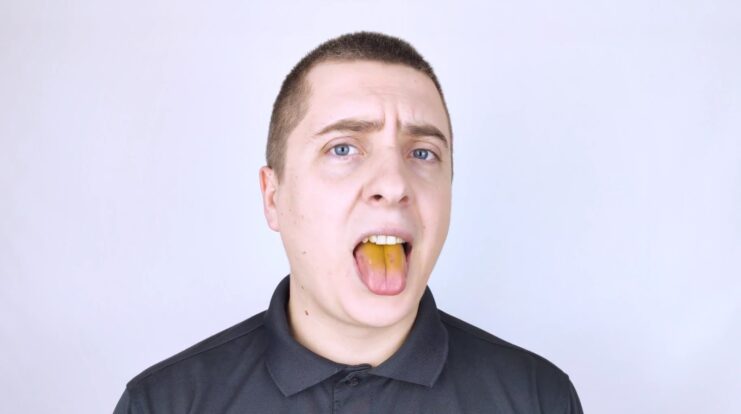Here we’ll delve into nine common and uncommon conditions that can affect the penile skin, exploring their causes, symptoms, treatments, and more. From sexually transmitted infections like herpes simplex to chronic skin conditions such as psoriasis, we’ll provide an in-depth understanding of these ailments.
It’s important to note that many of these conditions can have similar presentations and can only be differentiated accurately through medical evaluation.
If you’re experiencing any unusual symptoms, your first course of action should always be to consult a healthcare professional. Read on to gain vital knowledge about these conditions, and remember, early detection and treatment can often lead to better outcomes.
1. Herpes Simplex
This presents classically as a cluster of 3 to 5 painful blisters. Each blister is 3mm to 5mm in diameter. The skin under the blisters is always red. Herpes is transmitted by sexual contact even oral sex.

2. Fixed Drug Eruption
This is caused by an allergy to medicines, foods or supplements. It can occur up to 2 weeks after having ingested the medicine or supplement. It looks like a dark oval with sharp edges and is between 0.5cm and 5cm in diameter. The centre may be wet or even have blisters. It may feel itchy, burning or even painful. These lesions fade away by themselves after a few weeks but leaves behind a permanently pigmented patch.
3. Erythroplasia of Queyrat aka Bowen’s Disease of the Penis aka in situ Squamous Cell Carcinoma of the penis
This is a skin cancer of the penis. It occurs more often in uncircumcised men. It presents as a single (sometimes multiple) lump or patch on the head of the penis. It can look either velvety or scaly. It is never painful.
4. Lichen Planus
This is caused by a problem with the immune system. It appears as a pink, fruity, polygonal flat lump that varies from 1mm to 1cm in size. It can be single or multiple arranged in lines or circles. Most of these will go away by themselves in 6 to 18 months. People will Lichen Planus may also be suffering from other immune related problems like Alopecia Areata. Sometimes, Lichen Planus occurs in people who are infected with Hepatitis C or other form of Hepatitis.
5. Lichen Sclerosus aka Balanitis Xerotica Obliterans
This is a chronic inflammatory skin condition. Most times the cause is unknown but it may be caused by HPV infection or radiotherapy. It increases the risk of skin cancer. Early on in the disease, it may look very mild like a mildly red or lighter coloured patch. As it progresses, it becomes a white thick scar. It can cause pain or a burning sensation. It can even cause pain while passing urine.
6. Candidiasis

This is caused by a fungal infection of the head of the penis. People with a poor immune system (e.g. Uncontrolled Diabetics, Untreated HIV) have a higher risk of developing this problem. It appears as white patches on the skin (looks like milk curds). If a patient tries to scrape away these patches, the base will bleed. It is easily treated with anti-fungal medicines however, the patient should also be screened for Diabetes or any other disease that may be compromising his immune system.
7. Pemphigus Vulgaris
This is caused by an over-active immune system almost like an “internal allergy”. It appears as flaccid blisters. These blisters are very fragile and break easily forming erosions. It can be controlled with steroid creams. It may be dangerous if it involves a big area of skin other than the genitals.
8. Psoriasis

Psoriasis is a chronic inflammatory skin condition. It presents as scaly salmon-pink ovals on the skin. The borders are very well demarcated. They can be itchy. Psoriasis can also affect many other areas of the body. It is a chronic condition that cannot be cured. But it can be controlled by various creams and light therapy. Psoriasis can also lead to joint pain.
9. Balanitis Circumscripta Plasmacellularis aka Zoon Balanitis aka Plasma cell balanitis
This is very rare and is caused by the body’s antibodies attacking its own cells. It usually happens in middle age to older men who are not circumcised. It looks like a single, glistening, shiny, red to orange patch on the skin. It can be treated with special creams. Circumcision has also been shown to cure it.
Preventive Measures

Promoting penile health involves several essential steps that are generally applicable across the board, and may help to prevent the onset of certain conditions:
- Safe Sexual Practices: Always use protection during sexual intercourse to reduce the risk of sexually transmitted infections like herpes simplex. Regular testing for STIs can help detect and treat them early if they occur.
- Hygiene: Good hygiene practices are crucial. Regular cleaning of the penis with warm water and mild, unscented soap can help prevent the buildup of bacteria and fungi that can lead to conditions like candidiasis.
- Healthy Lifestyle Choices: This includes maintaining a healthy weight, eating a balanced diet, and regular exercise. These factors all contribute to a healthy immune system which is vital in preventing conditions caused by immune system disorders such as lichen planus and psoriasis.
- Regular Check-ups: Regular health check-ups are essential for early detection and treatment of many conditions. If you notice any unusual changes, seek medical advice promptly.
Detailed Treatment Options
The treatment for these conditions can vary, but here are some general approaches:
- Herpes Simplex: Antiviral medications such as acyclovir, valacyclovir, and famciclovir are commonly used to manage outbreaks and reduce the risk of transmission.
- Fixed Drug Eruption: Once the offending agent is identified and discontinued, topical steroids may be used to alleviate symptoms.
- Erythroplasia of Queyrat: Treatment often involves surgical removal, laser therapy, or topical chemotherapy.
- Lichen Planus: Treatments include corticosteroids (topical or oral), retinoids, and immunosuppressants, based on the severity of the condition.
- Lichen Sclerosus: High-potency topical corticosteroids are the first-line treatment. In some cases, circumcision may be recommended.
- Candidiasis: Antifungal creams or oral medication are typically prescribed.
- Pemphigus Vulgaris: Corticosteroids and other immune-suppressing drugs can help manage this condition.
- Psoriasis: Treatment often involves topical corticosteroids, vitamin D analogues, or light therapy. In severe cases, systemic treatments or biologic drugs may be necessary.
- Balanitis Circumscripta Plasmacellularis: Treatment often involves topical corticosteroids and, in some cases, circumcision may be recommended.
Remember, the effectiveness of these treatments can vary from person to person, and each has potential side effects. Always consult with your healthcare provider to find the best treatment plan for your specific condition.
Final Words
there are several common and uncommon conditions that can affect the skin of the penis. While some are primarily cosmetic concerns, others can lead to serious health complications if left untreated. It is vital to remember that many of these conditions present similarly and require professional medical evaluation for accurate diagnosis and treatment.
The importance of preventive measures, such as safe sexual practices, proper hygiene, and regular medical check-ups, cannot be overemphasized. These practices can help detect, prevent, or manage many of these conditions. Additionally, understanding the potential treatment options available provides a foundation for informed discussions with your healthcare provider about your specific condition and the most effective treatment plan for you.












